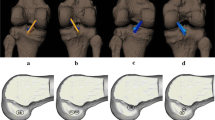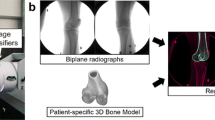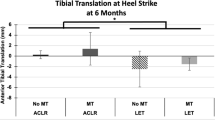Abstract
Purpose
Lateral extra-articular tenodesis (LET) may confer improved rotational stability after anterior cruciate ligament reconstruction (ACLR). Little is known about how LET affects in vivo cartilage contact after ACLR. The aim of this study was to investigate the effect of LET in combination with ACLR (ACLR + LET) on in vivo cartilage contact kinematics compared to isolated ACLR (ACLR) during downhill running. It was hypothesised that cartilage contact area in the lateral compartment would be larger in ACLR + LET compared with ACLR, and that the anterior–posterior (A–P) position of the contact center on the lateral tibia would be more anterior after ACLR + LET than after ACLR.
Methods
Twenty patients were randomly assigned into ACLR + LET or ACLR during surgery (ClinicalTrials.gov:NCT02913404). At 6 months and 12 months after surgery, participants were imaged during downhill running using biplane radiography. Tibiofemoral motion was tracked using a validated registration process. Patient-specific cartilage models, obtained from 3 T MRI, were registered to track bone models and used to calculate the dynamic cartilage contact area and center of cartilage contact in both the medial and lateral tibiofemoral compartments, respectively. The side-to-side differences (SSD) were compared between groups using a Mann–Whitney U test.
Results
At 6 months after surgery, the SSD in A–P cartilage contact center in ACLR + LET (3.9 ± 2.6 mm, 4.4 ± 3.1 mm) was larger than in ACLR (1.2 ± 1.6 mm, 1.5 ± 2.0 mm) at 10% and 20% of the gait cycle, respectively (p < 0.01, p < 0.05). There was no difference in the SSD in cartilage contact center at 12 months after surgery. There was no difference in SSD of cartilage contact area in the medial and lateral compartments at both 6 and 12 months after surgery. There were no adverse events during the trial.
Conclusion
LET in combination with ACLR may affect the cartilage contact center during downhill running in the early post-operation phase, but this effect is lost in the longer term. This suggests that healing and neuromuscular adaptation occur over time and may also indicate a dampening of the effect of LET over time.
(337 /350 words)
Level of evidence
Level II.




Similar content being viewed by others
References
Akpinar B, Thorhauer E, Tashman S, Irrgang JJ, Fu FH, Anderst WJ (2019) Tibiofemoral cartilage contact differences between level walking and downhill running. Orthop J Sports Med 7:2325967119836164
Anderst W, Zauel R, Bishop J, Demps E, Tashman S (2009) Validation of three-dimensional model-based tibio-femoral tracking during running. Med Eng Phys 31:10–16
Ayeni OR, Chahal M, Tran MN, Sprague S (2012) Pivot shift as an outcome measure for ACL reconstruction: a systematic review. Knee Surg Sports Traumatol Arthrosc 20:767–777
Capin JJ, Khandha A, Zarzycki R, Manal K, Buchanan TS, Snyder-Mackler L (2018) Gait mechanics after ACL reconstruction differ according to medial meniscal treatment. J Bone Joint Surg Am 100:1209–1216
Castoldi M, Magnussen RA, Gunst S, Batailler C, Neyret P, Lustig S et al (2020) A randomized controlled trial of bone-patellar tendon-bone anterior cruciate ligament reconstruction with and without lateral extra-articular tenodesis: 19-year clinical and radiological follow-up. Am J Sports Med 48:1665–1672
Christel P, Djian P (2002) Anterio-lateral extra-articular tenodesis of the knee using a short strip of fascia lata. Rev Chir Orthop Reparatrice Appar Mot 88:508–513
Draganich LF, Reider B, Miller PR (1989) An in vitro study of the Muller anterolateral femorotibial ligament tenodesis in the anterior cruciate ligament deficient knee. Am J Sports Med 17:357–362
Engebretsen L, Lew WD, Lewis JL, Hunter RE (1990) The effect of an iliotibial tenodesis on intraarticular graft forces and knee joint motion. Am J Sports Med 18:169–176
Faul F, Erdfelder E, Lang AG, Buchner A (2007) G*Power 3: a flexible statistical power analysis program for the social, behavioral, and biomedical sciences. Behav Res Methods 39:175–191
Geeslin AG, Moatshe G, Chahla J, Kruckeberg BM, Muckenhirn KJ, Dornan GJ et al (2018) Anterolateral knee extra-articular stabilizers: a robotic study comparing anterolateral ligament reconstruction and modified Lemaire lateral extra-articular tenodesis. Am J Sports Med 46:607–616
Getgood AMJ, Bryant DM, Litchfield R, Heard M, McCormack RG, Rezansoff A et al (2020) Lateral extra-articular tenodesis reduces failure of hamstring tendon autograft anterior cruciate ligament reconstruction: 2-year outcomes from the stability study randomized clinical trial. Am J Sports Med 48:285–297
Grieco TF, Sharma A, Dessinger GM, Cates HE, Komistek RD (2018) In vivo kinematic comparison of a bicruciate stabilized total knee arthroplasty and the normal knee using fluoroscopy. J Arthroplasty 33:565–571
Harner CD, Irrgang JJ, Paul J, Dearwater S, Fu FH (1992) Loss of motion after anterior cruciate ligament reconstruction. Am J Sports Med 20:499–506
Hoshino Y, Araujo P, Ahlden M, Samuelsson K, Muller B, Hofbauer M et al (2013) Quantitative evaluation of the pivot shift by image analysis using the iPad. Knee Surg Sports Traumatol Arthrosc 21:975–980
Inderhaug E, Stephen JM, El-Daou H, Williams A, Amis AA (2017) The effects of anterolateral tenodesis on tibiofemoral contact pressures and kinematics. Am J Sports Med 45:3081–3088
Kaiser JM, Vignos MF, Kijowski R, Baer G, Thelen DG (2017) Effect of loading on in vivo tibiofemoral and patellofemoral kinematics of healthy and acl-reconstructed knees. Am J Sports Med 45:3272–3279
Kocher MS, Steadman JR, Briggs KK, Sterett WI, Hawkins RJ (2004) Relationships between objective assessment of ligament stability and subjective assessment of symptoms and function after anterior cruciate ligament reconstruction. Am J Sports Med 32:629–634
Kuster M, Wood GA, Sakurai S, Blatter G (1994) 1994 Nicola Cerulli Young researchers award. Downhill walking: a stressful task for the anterior cruciate ligament? A biomechanical study with clinical implications. Knee Surg Sports Traumatol Arthrosc 2:2–7
Lee MC, Seong SC, Lee S, Chang CB, Park YK, Jo H et al (2007) Vertical femoral tunnel placement results in rotational knee laxity after anterior cruciate ligament reconstruction. Arthroscopy 23:771–778
Leitze Z, Losee RE, Jokl P, Johnson TR, Feagin JA (2005) Implications of the pivot shift in the ACL-deficient knee. Clin Orthop Relat Res 436:229–236
Logan CA, Aman ZS, Kemler BR, Storaci HW, Dornan GJ, LaPrade RF (2019) Influence of medial meniscus bucket-handle repair in setting of anterior cruciate ligament reconstruction on tibiofemoral contact mechanics: a biomechanical study. Arthroscopy 35:2412–2420
Lopomo N, Signorelli C, Bonanzinga T, Marcheggiani Muccioli GM, Visani A, Zaffagnini S (2012) Quantitative assessment of pivot-shift using inertial sensors. Knee Surg Sports Traumatol Arthrosc 20:713–717
Marcacci M, Zaffagnini S, Iacono F, Vascellari A, Loreti I, Kon E et al (2003) Intra- and extra-articular anterior cruciate ligament reconstruction utilizing autogeneous semitendinosus and gracilis tendons: 5-year clinical results. Knee Surg Sports Traumatol Arthrosc 11:2–8
Miranda DL, Fadale PD, Hulstyn MJ, Shalvoy RM, Machan JT, Fleming BC (2013) Knee biomechanics during a jump-cut maneuver: effects of sex and ACL surgery. Med Sci Sports Exerc 45:942–951
Mohtadi N, Chan D, Barber R, Oddone Paolucci E (2015) A randomized clinical trial comparing patellar tendon, hamstring tendon, and double-bundle ACL reconstructions: patient-reported and clinical outcomes at a minimal 2-year follow-up. Clin J Sport Med 25:321–331
Nagai K, Gale T, Herbst E, Tashiro Y, Irrgang JJ, Tashman S et al (2018) Knee hyperextension does not adversely affect dynamic in vivo kinematics after anterior cruciate ligament reconstruction. Knee Surg Sports Traumatol Arthrosc 26:448–454
Noyes FR, Barber SD (1991) The effect of an extra-articular procedure on allograft reconstructions for chronic ruptures of the anterior cruciate ligament. J Bone Joint Surg Am 73:882–892
O’Brien SJ, Warren RF, Wickiewicz TL, Rawlins BA, Allen AA, Panariello R et al (1991) The iliotibial band lateral sling procedure and its effect on the results of anterior cruciate ligament reconstruction. Am J Sports Med 19:21–25
Pernin J, Verdonk P, Si Selmi TA, Massin P, Neyret P (2010) Long-term follow-up of 24.5 years after intra-articular anterior cruciate ligament reconstruction with lateral extra-articular augmentation. Am J Sports Med 38:1094–1102
Prodromos CC, Joyce BT, Shi K, Keller BL (2005) A meta-analysis of stability after anterior cruciate ligament reconstruction as a function of hamstring versus patellar tendon graft and fixation type. Arthroscopy 21:1202
Rezende FC, de Moraes VY, Martimbianco AL, Luzo MV, da Silveira Franciozi CE, Belloti JC (2015) Does combined intra- and extraarticular ACL reconstruction improve function and stability? A meta-analysis. Clin Orthop Relat Res 473:2609–2618
Salem HS, Varzhapetyan V, Patel N, Dodson CC, Tjoumakaris FP, Freedman KB (2019) Anterior cruciate ligament reconstruction in young female athletes: patellar versus hamstring tendon autografts. Am J Sports Med 47:2086–2092
Samuelson M, Draganich LF, Zhou X, Krumins P, Reider B (1996) The effects of knee reconstruction on combined anterior cruciate ligament and anterolateral capsular deficiencies. Am J Sports Med 24:492–497
Shimakawa T, Burkhart TA, Dunning CE, Degen RM, Getgood AM (2019) Lateral compartment contact pressures do not increase after lateral extra-articular tenodesis and subsequent subtotal meniscectomy. Orthop J Sports Med 7:2325967119854657
Tashman S, Anderst W (2003) In-vivo measurement of dynamic joint motion using high speed biplane radiography and CT: application to canine ACL deficiency. J Biomech Eng 125:238–245
Tashman S, Collon D, Anderson K, Kolowich P, Anderst W (2004) Abnormal rotational knee motion during running after anterior cruciate ligament reconstruction. Am J Sports Med 32:975–983
Tashman S, Kolowich P, Collon D, Anderson K, Anderst W (2007) Dynamic function of the ACL-reconstructed knee during running. Clin Orthop Relat Res 454:66–73
Thorhauer E, Tashman S (2015) Validation of a method for combining biplanar radiography and magnetic resonance imaging to estimate knee cartilage contact. Med Eng Phys 37:937–947
Vadala AP, Iorio R, De Carli A, Bonifazi A, Iorio C, Gatti A et al (2013) An extra-articular procedure improves the clinical outcome in anterior cruciate ligament reconstruction with hamstrings in female athletes. Int Orthop 37:187–192
Van de Velde SK, Gill TJ, Li G (2009) Evaluation of kinematics of anterior cruciate ligament-deficient knees with use of advanced imaging techniques, three-dimensional modeling techniques, and robotics. J Bone Joint Surg Am 91(Suppl 1):108–114
Webster KE, Feller JA (2016) Exploring the high reinjury rate in younger patients undergoing anterior cruciate ligament reconstruction. Am J Sports Med 44:2827–2832
Yabroudi MA, Irrgang JJ (2013) Rehabilitation and return to play after anatomic anterior cruciate ligament reconstruction. Clin Sports Med 32:165–175
Yunes M, Richmond JC, Engels EA, Pinczewski LA (2001) Patellar versus hamstring tendons in anterior cruciate ligament reconstruction: a meta-analysis. Arthroscopy 17:248–257
Zaffagnini S, Marcheggiani Muccioli GM, Grassi A, Roberti di Sarsina T, Raggi F, Signorelli C et al (2017) Over-the-top ACL reconstruction plus extra-articular lateral tenodesis with hamstring tendon grafts: prospective evaluation with 20-year minimum follow-up. Am J Sports Med 45:3233–3242
Acknowledgements
None.
Funding
Funding was received from the Department of Orthopaedic Surgery at the University of Pittsburgh.
Author information
Authors and Affiliations
Contributions
KN chiefly drafted the manuscript and carried out the acquisition of data and the analysis and interpretation of data. TG, DC, FS, and BL carried out the acquisition of data. WA and VM carried out the design of the study and revised the manuscript. FF conducted final approval of the manuscript to be submitted. All the authors read and approved the final manuscript.
Corresponding author
Ethics declarations
Conflict of interest
FF receives personal fees and non-financial support from Smith & Nephew. VM receives grants and personal fees from Smith & Nephew and grants from Arthrex.
Ethical approval
IRB-approved study (IRB No. 19060375).
Informed consent
A total of 20 patients provided informed written consent to participate.
Additional information
Publisher's Note
Springer Nature remains neutral with regard to jurisdictional claims in published maps and institutional affiliations.
Rights and permissions
About this article
Cite this article
Nishida, K., Gale, T., Chiba, D. et al. The effect of lateral extra-articular tenodesis on in vivo cartilage contact in combined anterior cruciate ligament reconstruction. Knee Surg Sports Traumatol Arthrosc 30, 61–70 (2022). https://doi.org/10.1007/s00167-021-06480-4
Received:
Accepted:
Published:
Issue Date:
DOI: https://doi.org/10.1007/s00167-021-06480-4




